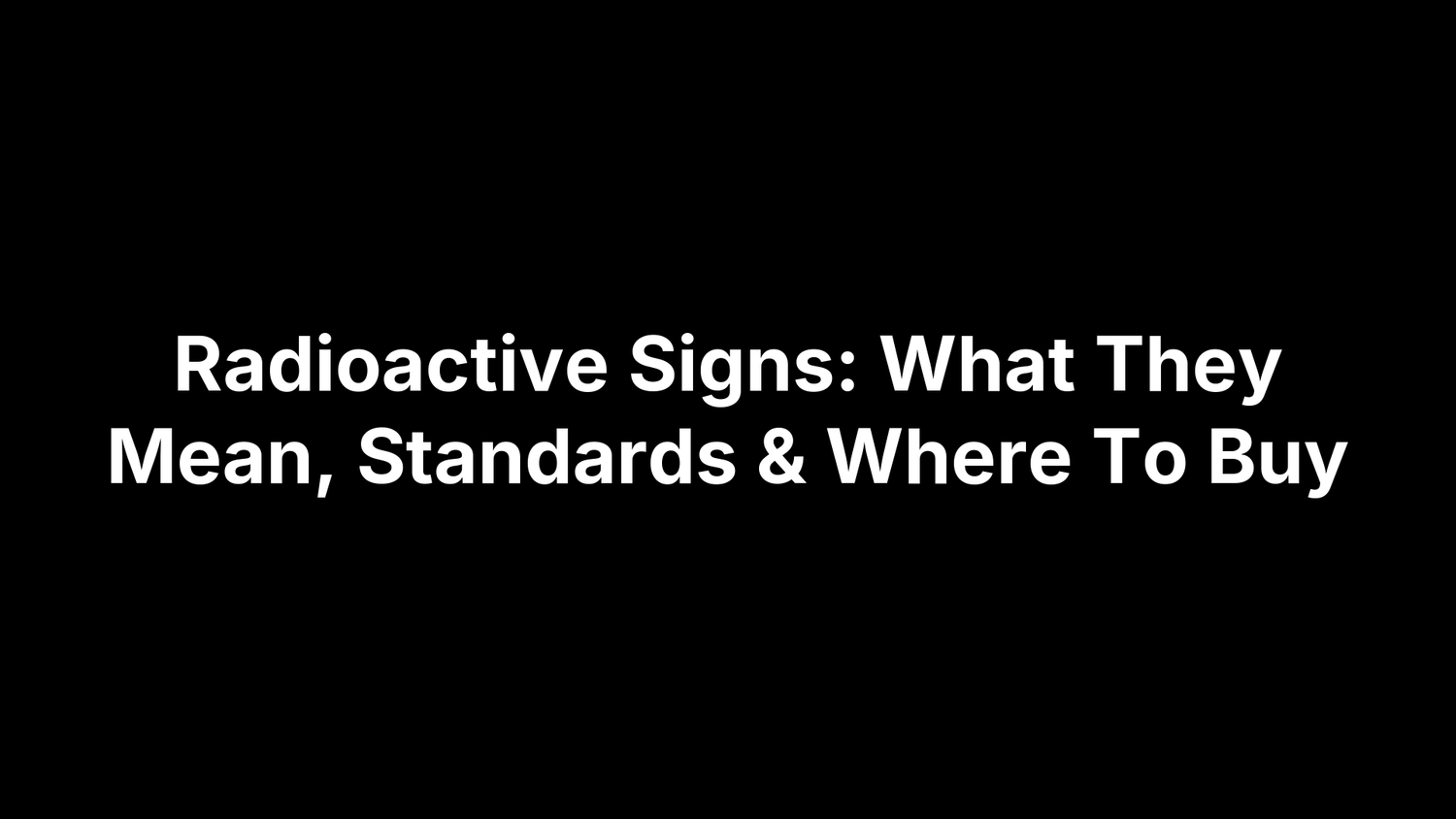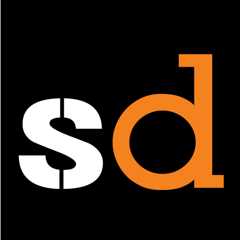Radioactive Signs: What They Mean, Standards & Where To Buy
Radioactive signs are safety warnings that use the trefoil symbol to alert people to ionizing radiation—think X‑ray rooms, sealed sources, nuclear gauges, and radioactive material storage. The symbol is typically magenta or black on yellow and is required anywhere certain doses could be received or regulated materials are present, helping prevent accidental exposure and supporting compliance.
This guide explains the trefoil’s meaning and how to use it correctly. You’ll learn the governing standards (OSHA, ANSI/ASSP Z535, ISO 7010, NRC, IAEA), required wording by area classification, layout and signal words, placement and size, color specs, materials, the additional hazard symbol, how to choose and customize, where to buy compliant signs, and grab free artwork files.
The trefoil at a glance: symbol anatomy, colors and meaning
The trefoil is the heart of radioactive signs: a central circle with three curved blades set equidistant around it. Standard usage places the shapes in magenta or black on a yellow field to command attention. The circle reads as the source; the blades represent ionizing emissions—alpha, beta and gamma. Wherever regulated radioactive material or radiation‑producing devices are present, this universally recognized symbol communicates “radiation—take caution,” regardless of language.
Standards and regulations that govern radioactive signs (OSHA, ANSI/ASSP Z535, ISO 7010, NRC, IAEA)
In the U.S., radioactive signs are guided by both regulation and consensus standards. OSHA governs workplace safety, and facilities use compliant radiation warning signs to support OSHA compliance. The U.S. Nuclear Regulatory Commission (NRC) defines the radiation warning symbol—a magenta or black trefoil on yellow—and requires it where certain quantities of radioactive material are present or where doses could be received. For how a sign looks and reads, many safety programs apply the ANSI/ASSP Z535 series for signal words, layout and color coding. Internationally, ISO 7010 registers the ionizing radiation symbol as W003, and the IAEA issues safety standards (including the supplementary high‑activity source symbol) to improve universal understanding. Together, these frameworks drive consistent, compliant signage.
U.S. radiation area classifications and required sign text
In the U.S., the NRC requires radiation warning postings wherever regulated sources or doses may be present. To keep your radioactive signs consistent and compliant, match the area classification to clear, prescriptive wording. Facilities typically pair the trefoil with a signal word and the area name; your Radiation Safety Officer (RSO) should confirm thresholds and exact phrasing for your license.
- Radiation Area: “Caution: Radiation Area”
- High Radiation Area: “Caution” or “Danger: High Radiation Area”
- Very High Radiation Area: “Grave Danger: Very High Radiation Area”
- Airborne Radioactivity Area: “Caution: Airborne Radioactivity Area”
- Radioactive Materials (storage/use): “Caution: Radioactive Materials”
Always verify posting locations and wording against NRC/state requirements and site procedures.
Signal words and layout: applying ANSI Z535 to radiation signage
ANSI/ASSP Z535 turns the trefoil into a complete, readable message. For radioactive signs, use an ANSI signal-word header and message panel, while preserving the NRC/ISO trefoil in magenta or black on yellow. Pair the required NRC area wording with a short, specific message so workers immediately grasp the hazard and controls.
- Select the signal word: Align with your posting—Caution (Radiation Area, Airborne Radioactivity Area), Danger for higher hazards as permitted, and NRC’s “Grave Danger” only for Very High Radiation Areas.
- Build the layout: Signal-word header at the top; trefoil placed prominently; required area text; concise hazard details (source/equipment, dose potential if appropriate); and entry/control notes per procedure.
- Keep it legible: High contrast, consistent format, no altered trefoil, and plain language. For bilingual signs, keep required NRC wording intact and add translations below.
Placement, size and visibility requirements
The NRC requires radiation warning symbols to be displayed wherever certain quantities of radioactive material are present or where doses could be received. In practice, place radioactive signs where people decide to enter or interact with equipment, and make them unmistakable at first glance. Use ANSI/ASSP Z535 principles for readability and consistency so workers can recognize and act on the message quickly across the facility.
- Post at every entrance and access point: Doors, hatches, fenced areas, and temporary barricades.
- Mark equipment and housings: X‑ray units, gauges, irradiators, storage cabinets.
- Ensure line‑of‑sight: Mount at eye level, unobstructed by racks or open doors.
- Size for viewing distance: Choose letter height and symbol size appropriate to how far readers stand, following ANSI Z535 legibility guidance.
- Maintain contrast and lighting: Good illumination and clean surfaces.
- Keep current and durable: Replace faded, damaged, or outdated radiation signs.
- Match your audience: Add bilingual text where needed without altering required wording.
Color specs and correct artwork files
Color is the first compliance check. Across standards, the ionizing radiation trefoil on radioactive signs must appear in magenta or black on a yellow background—ISO 7010 (W003) commonly uses black on yellow, while U.S. programs accept magenta on yellow as codified by ANSI and referenced by the NRC. Preserve the trefoil’s exact geometry and high contrast for instant recognition.
- Approved pairings: Magenta-on-yellow (U.S.) or black-on-yellow (ISO/IAEA).
- Keep geometry intact: Equal blades, central circle; don’t stretch, stylize, or add effects.
- Use vector masters: SVG/EPS/PDF to scale cleanly without distortion.
- Solid yellow field: No photos, patterns, or tinted backgrounds; maintain a clear quiet zone around the symbol.
Common types of radioactive signs and labels you might need
Choosing the right radioactive signs starts with matching the posting to the hazard, location, and task. Most programs standardize on a core set so workers instantly recognize the message anywhere on site.
- Radiation Area postings: Door/entry signs for controlled areas.
- High/Very High Radiation Area: Elevated dose areas with stronger signal words.
- Airborne Radioactivity Area: Entries where airborne risks may exist.
- Radioactive Materials storage: Cabinets, rooms, or cages.
- X‑Ray in Use/Active source: Equipment status and interlocked rooms.
- Device/equipment labels: Gauges, irradiators, housings.
- Temporary/barricade postings: Work-in-progress zones and outages.
- Bilingual variants: English/Spanish for mixed workforces.
The additional radiation hazard symbol: when to use it—and when not to
In 2007, the IAEA and ISO introduced a supplementary radiation hazard symbol to reinforce the standard trefoil. It’s a red triangle showing radiation waves, a skull, and a running person—designed to convey “Danger — Run Away — Do Not Touch!” at a glance. Use this additional symbol for high‑activity sources (IAEA categories 1–3) on the source, its shield, or under device covers as a last‑chance warning alongside your regular radioactive signs.
Don’t treat it as a replacement for the trefoil. The IAEA advises against placing this symbol on building entrances, shipping packages, freight containers, or exterior device housings. For area postings and general equipment labels, stick with the standard trefoil on yellow per NRC/ISO 7010 and your RSO’s procedures—reserve the supplementary symbol for concealed, high‑risk sources only.
Materials and durability: choosing the right substrate and finish
For radioactive signs that stay legible, match the material to the environment. Rigid aluminum excels outdoors and on doors; durable plastic works in clean interiors; laminated vinyl or polyester labels bond to equipment and curved housings. Prioritize UV‑stable inks, overlaminates against abrasion and chemicals, and adhesives rated for temperature and surface type. In low‑light approaches, reflective yellow (e.g., conspicuity sheeting) can boost visibility—while keeping the trefoil’s magenta/black‑on‑yellow contrast intact.
How to choose and customize a compliant sign for your facility
Choosing and customizing radioactive signs is a compliance exercise, not a design project. Align each posting with NRC requirements, then apply ANSI/ASSP Z535 for layout, signal words, and legibility. Tailor materials and copy without altering the trefoil or the magenta/black‑on‑yellow scheme.
- Verify the area classification with your RSO.
- Select the correct signal word.
- Use exact NRC area wording.
- Keep the trefoil unaltered; magenta/black on yellow.
- Add one clear hazard/control line.
- Size/material for viewing distance and environment.
- Reserve the red supplementary symbol for concealed high‑activity sources—not entrances.
Where to buy compliant radioactive signs
For compliant radioactive signs, buy from Safety Decals—Michigan-based specialists—or other reputable industrial safety suppliers. Safety Decals builds customizable radiation warning signs aligned to OSHA/NRC requirements, using ANSI/ASSP Z535 layout and ISO 7010 trefoil artwork, on durable ORAFOL materials for long service.
- Compliance support: NRC area wording, ANSI signal words, ISO 7010 trefoil.
- Custom sizes and substrates: Aluminum, plastic, laminated vinyl; reflective conspicuity sheeting (ORALITE).
- Artwork help: Plus a Sticker Builder for equipment labels.
- Consistent production: Sitewide standardization and easy reorders.
Free symbol files and templates (downloadables)
Save time and stay compliant with free, standards‑based files for radioactive signs. Get vector trefoil artwork (ISO 7010 W003) in SVG/EPS/PDF and print‑ready ANSI/ASSP Z535 templates for “Radiation Area,” “High Radiation Area,” “Airborne Radioactivity Area,” and “Radioactive Materials.” Artwork preserves magenta/black‑on‑yellow, correct geometry, and clear space—just add your site specifics and print.
Common mistakes to avoid with radioactive signs
Even good programs slip on details that undercut compliance and clarity. Stay faithful to the trefoil, required NRC wording, and ANSI/ASSP Z535 format. Use the quick checklist below to prevent the mistakes that most often derail radioactive signs and confuse workers.
- Altering the trefoil or colors: Keep magenta/black on yellow.
- Skipping required wording: NRC area text and proper signal words.
- Misusing the extra symbol: Don’t put the red supplementary symbol on entrances.
- Poor visibility: Signs too small, blocked, or poorly lit.
- Not maintaining postings: Faded, damaged, or outdated signs left in place.
Frequently asked questions
Quick answers to common questions about radioactive signs to sanity-check postings with your RSO.
- Are black‑on‑yellow trefoils allowed? Yes—NRC permits magenta or black on yellow; don’t alter colors or geometry.
- Where must postings go? Entrances/access points and on equipment/storage where regulated sources or doses exist.
- When should I use the red supplementary symbol? Only for concealed high‑activity sources; never on entrances (IAEA).
- Can signs be bilingual or reflective? Yes—keep required NRC wording, yellow field, contrast, and legibility.
Key takeaways
Radioactive signs work when the trefoil is correct, wording matches the area, and layout, colors, and placement follow recognized rules (NRC, ANSI/ASSP Z535, ISO 7010; IAEA for the supplementary symbol). For compliant, durable postings and quick customization, shop Safety Decals.
- Keep trefoil magenta/black on yellow; don’t alter geometry.
- Use exact NRC area text with proper signal word.
- Reserve the red supplementary symbol for concealed high‑activity sources.


